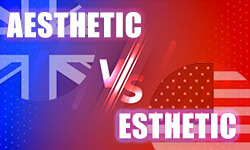
The extensive spread of the English language across the globe has given rise to various dialects, each with its unique pronunciation and spelling variations. Achieving linguistic uniformity is essential in academic writing to ensure coherence and keep within the standards of academic integrity. The divergence between British English vs. American English is the most prominent one, entailing notable spelling differences. We will delve into the case of “aesthetic” and “esthetic” below.
“Aesthetic” or “esthetic”
“Aesthetic” or “esthetic” can be adjectives and nouns. Used as an adjective, it describes something that pertains to the appreciation of beauty or the appearance of something. It refers to the principles, guiding the work of an artist or the work of art itself.
When “aesthetic/esthetic” is used as a noun, it refers to a particular taste for what is pleasing to the senses, especially sight. An “aesthetic/esthetic” typically revolves around a set of principles underlying and guiding the work of a certain artist or artistic movement. It can also be attributed to a branch of philosophy that deals with the nature of art, beauty, and taste.
These terms are both variants of the same word, varying mainly in spelling between British and American English, with “aesthetic” with an “a” in the initial position being the more common form worldwide.

British English
aesthetic

American English
aesthetic
esthetic
Both “aesthetic” and “esthetic” are spelled correctly, but are conventional in different English variants, like British and American English. While “aesthetic” with an extra “a” at the beginning is accepted in both English variants, “esthetic” with the “a” omitted is only correct in the American spelling. It is integral to stick to the English variant you choose throughout your whole paper to maintain academic integrity and credibility. In other words, you must not alternate between different English variants.
Note: “Aesthetic” is the more common spelling in both British English and American English in the context of beauty, arts, and the philosophical study of what is pleasing to the eye. It is universally recognized and preferred in academia, philosophy, and overall use across English speakers.
Examples of using “aesthetic” and “esthetic” as a noun
The following examples showcase the correct use of the different spellings of “aesthetic/esthetic” as a noun in sentence structures.
- British English: “Aesthetic”
- American English: “Aesthetic/esthetic”


Examples of using “aesthetic” and “esthetic” as an adjective
Used as an adjective, “aesthetic/esthetic” takes on a different placement in sentence structures, as shown in the examples below.
- British English: “Aesthetic”
- American English: “Aesthetic/esthetic”


An alternative spelling of the adjective “aesthetic/esthetic” is “aesthetical” or “esthetical.” Both forms are adjectives that describe something related to art or the appreciation of beauty. While “aesthetic/esthetic” is the preferred form in both British and American English, “aesthetical/esthetical” is occasionally used as well. The following presents a few examples of using the word correctly in both English variants.
- British English: “Aesthetical”
- American English: “Aesthetical/esthetical”


“Aesthetic” or “esthetic” as an adverb
When “aesthetic/esthetic” is used as an adverb to modify adjectives, verbs, or other adverbs, it takes on the form of “aesthetically” or “esthetically.” The following shows examples of using the adverb correctly.
- British English: “Aesthetically”
- American English: “Aesthetically/esthetically”


“Aesthetic” or “esthetic” as a verb
Though not commonly used, the related verb for “aesthetic/esthetic” is “to aestheticise” or “to aestheticize /estheticize.” The verb has the function of conveying the act of applying aesthetic principles to something, or the process of rendering something in terms of its aesthetic values. The following examples shed more light on using it in context.
- British English: “To aestheticise”
- American English: “To aestheticize/estheticize”


“Aesthetic” or “esthetic” in the “-ing” form
The verb “aestheticise/aestheticize/estheticize” can be inflected in the “-ing” form to indicate a gerund or a present participle. The sentences below show examples following the spelling conventions of British and American English.
- British English: “Aestheticising”
- American English: “Aestheticizing/estheticizing”


“Aesthetic” or “esthetic” in the “-ed” form
When the verb “to aestheticise/aestheticize/estheticize” is inflected in the “-ed” form, it implies the past tense or past participle. The examples below illustrate the correct use of it in British and American English.
- British English: “Aestheticised”
- American English: “Aestheticized/estheticized”


“Aesthetic” or “esthetic” in the plural form
The meaning of “aesthetic/esthetic” slightly changes when it is used in its plural form, “aesthetics/esthetics.” The plural is commonly used to refer to the general study or philosophy of beauty in arts, literature, and nature. If you describe something about the appreciation of beauty or a specific taste, the singular version is the correct choice. The following examples show using “aesthetics/esthetics” in sentences.
- British English: “Aesthetics”
- American English: “Aesthetics/esthetics”


FAQs
“Aesthetic” and “esthetic” are essentially the same word with the same meaning but refer to the different spellings of British and American English. While “aesthetic” is universally recognized, “esthetic” is only common in American English.
In American English, “aesthetic” and “esthetic” are accepted ways of spelling. However, “aesthetic” is the preferred version.
“Aesthetic” or “esthetic” defines a particular taste for what is pleasing to the eye. In the context of “my aesthetic/esthetic,” it refers to your personal style, look, or how you approach situations in terms of what you perceive as compelling and beautiful.
In Canada, “aesthetic” is the preferred version. “Esthetic” is a possible spelling in the United States.
Three commonly known aesthetics are imitationalism, formalism, and emotionalism.
Printing Your Thesis With BachelorPrint
- High-quality bindings with customizable embossing
- 3D live preview to check your work before ordering
- Free express delivery
Configure your binding now!
